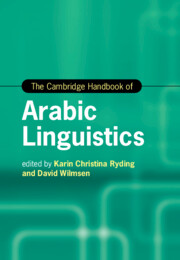Book contents
- The Cambridge Handbook of Arabic Linguistics
- Cambridge Handbooks in Language and Linguistics
- The Cambridge Handbook of Arabic Linguistics
- Copyright page
- Contents
- Figures
- Tables
- Notes on Contributors
- Acknowledgements
- Abbreviations
- Introduction
- Part I Arabic Applied Linguistics
- Part II Arabic Variation and Sociolinguistics
- Part III Theoretical and Descriptive Studies
- 12 Grammaticalization in Arabic
- 13 Arabic and Onomastics
- 14 The Intonation of Arabic
- 15 Case in Arabic
- 16 On Arabic Morphosyntax and Its Implications for the Theory of Generative Grammar
- 17 Arabic Morphology
- Part IV Arabic Computational and Corpus Linguistics
- Part V Arabic Linguistics and New Media Studies
- Part VI Arabic Linguistics in Literature and Translation
- Index
- References
17 - Arabic Morphology
Inflectional and Derivational
from Part III - Theoretical and Descriptive Studies
Published online by Cambridge University Press: 23 September 2021
- The Cambridge Handbook of Arabic Linguistics
- Cambridge Handbooks in Language and Linguistics
- The Cambridge Handbook of Arabic Linguistics
- Copyright page
- Contents
- Figures
- Tables
- Notes on Contributors
- Acknowledgements
- Abbreviations
- Introduction
- Part I Arabic Applied Linguistics
- Part II Arabic Variation and Sociolinguistics
- Part III Theoretical and Descriptive Studies
- 12 Grammaticalization in Arabic
- 13 Arabic and Onomastics
- 14 The Intonation of Arabic
- 15 Case in Arabic
- 16 On Arabic Morphosyntax and Its Implications for the Theory of Generative Grammar
- 17 Arabic Morphology
- Part IV Arabic Computational and Corpus Linguistics
- Part V Arabic Linguistics and New Media Studies
- Part VI Arabic Linguistics in Literature and Translation
- Index
- References
Summary
This chapter takes us on a survey of morphological categories, both derivational and inflectional, focusing not only on MSA but even more particularly on Yemeni, Saudi, and Egyptian dialects in contrastive analysis. Starting with the basics of Arabic derivation, Watson notes the key templatic nature of Arabic word formation and reviews concepts such as verb valency and different types of noun categories. In her discussion of Arabic inflectional categories, Watson covers number, gender, person, aspect, tense, mood, voice, degree, and definiteness.
- Type
- Chapter
- Information
- The Cambridge Handbook of Arabic Linguistics , pp. 405 - 424Publisher: Cambridge University PressPrint publication year: 2021



